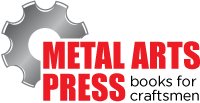- Acknowledgements
- Introduction
- Chapter 1: Measurement Tools, Layout & Job Planning
- Chapter 2: Basic Hand Tools
- Chapter 3: Filing & Sawing
- Chapter 4: Grinding, Reaming, Broaching & Lapping
- Chapter 5: Drills & Drilling Operations
- Chapter 6: Threads & Threading
- Chapter 7: Turning Operations
- Chapter 8: Milling Operations
- Chapter 9: Fastening Methods
- Chapter 10: Why Steel Hardens
- Chapter 11: Safety & Good Shop Practices
- Chapter 12: Other Shop Know-how
- Appendix I: Sharpening Steel Lathe Tools
- Appendix II: Surface Speed Table & Cutting Tool Selector Chart
- Appendix III: Decimal Equivalents of Fractional, Letter & Metric Drills
- Glossary
- Index
Chapter 6
Threads & Threading
You can never plan the future by the past.
—Edmund Burke
Introduction
Screw threads were used in the time of Plato, about 500 BC, in grape and olive presses. About one hundred years later, Archimedes was credited with inventing a water pump based on the screw to irrigate crops and remove water from ship bilges. Later the Romans used this pump to dewater mines. Until the English instrument maker, Jesse Ramsden, developed the first satisfactory screw-cutting lathe in 1770, all screw threads were cut by hand. This limited most threads to large wooden ones for presses and clamps until 1800 when Henry Maudslay, a talented machinist, produced a large screw-cutting lathe.
The development of steam engines, trains, and machine tools created a demand for threads in the form of nuts, bolts, and leadscrews. But lack of standardization was a great obstacle to the widespread use of threaded fasteners since each workshop had its own fastener designs and they were not interchangeable.
To overcome these problems, Joseph Whitworth collected sample screws from a large number of British workshops, and in 1841 proposed that the thread angle be standardized at 55° and that the number of threads per-inch should be standardized for various diameters. His proposals became standard practice in Britain in the 1860s.
In 1864 William Sellers of Pennsylvania, an engineer and machine tool builder, independently proposed another standard based on a 60° thread, and set thread pitches for different diameters. This was adopted as the U.S. Standard, and subsequently developed into the American Standard Coarse Series (NC) and the Fine Series (NF). In Continental Europe, several different thread standards emerged, but German and French standards based on the metric system and a 60° thread prevailed, and metric threads were established.
Section I – Thread Basics
Thread Uses
What are four important uses for threads?
Threads are used to:
- Actuate other mechanical components, like leadscrews on lathes and wing flaps on aircraft.
- Measure distance as with micrometer threads.
- Adjust and hold length as with tie rods and turnbuckles.
- Fasten as with nuts and bolts.
Parts of a Thread
What are the basic parts of a thread?
- Major diameter, the outer or largest diameter.
- Minor diameter, the smallest diameter.
- Pitch, the distance between adjoining threads.
- Form, the profile or shape of a thread.
See Figure 6–1.
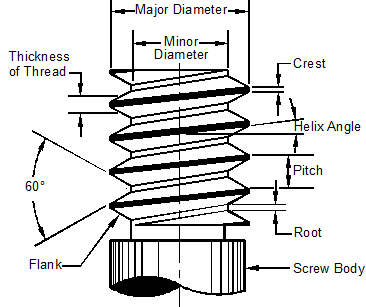
Figure 6–1. Parts of a thread.
Basis & Characteristics of Threads
What is the basis of threads?
Screw threads are really wedges wrapped around a cylinder, Figure 6–2.
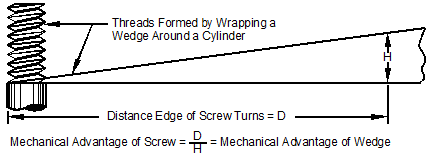
Figure 6–2. A screw thread and the wedge that formed it.
What are the special characteristics of screw threads?
Screw threads have the same mechanical advantage as the wedge that formed them. Figure 6–2 shows a wedge and screw thread with a mechanical advantage of about 7, the ratio of the distance the screw turns around the cylinder to the distance the screw moves vertically. This mechanical advantage enables screw jacks to lift heavy loads.
Measuring & Identifying Threads
How are threads measured?
Here are several ways to measure threads:
- Use a screw-thread micrometer, as in Figure 6–3, which differs from a regular micrometer in having a cone-shaped spindle and a mating anvil. These just fit over threads and measure the outside diameter (or major diameter) of the thread less the depth of one thread. This method works well for threading operations because the work does not have to be removed from the lathe to take the measurement.

Figure 6–3. Screw-thread micrometer (top) and positions of its
anvil and spindle corresponding to the zero position (bottom).
- The three-wire method, Figure 6–4, uses a regular micrometer placed over three same-size wires of a specific diameter for the thread being measured. Entering the thread dimensions into the formula that follows yields the diameter over the wires for a full-depth 60º American National Thread. This method works well for lathe threading operations since it can be done while the work remains in the lathe. Here is the formula:

Where: M = Measurement over the wires
D = Major diameter of the thread
G = Diameter of the wires
P = Pitch = 1/N
N = Number of threads/inch (tpi)
The largest wire size = GLargest =  = 1.010 P
= 1.010 P
The best wire size = GBest =  = 0.57735 P
= 0.57735 P
The smallest wire size = GSmallest =  = 0.505 P
= 0.505 P
Note: G must be no larger or no smaller than the sizes shown above.
Any wire size between the largest and smallest may be used.
All wires must be the same size.

Figure 6–4. Three-wire method.
- The thread triangle method, Figure 6–5, measures the distance over a pair of steel triangles between the thread roots. A reference chart is then used to determine thread depth. This measuring method also works well for lathe threading while the work remains in the lathe. Triangles are awkward to use, hard to position and are to be avoided, if at all possible.
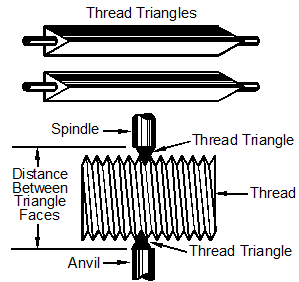
Figure 6–5. Thread triangle method.
- Thread ring gages and plug gages, as in Figure 6–6, are commercial master thread gages for external and internal threads. These are highly accurate and often used in pairs of Go and No-Go dimensions. Work may have to be removed from the lathe to measure external threads between centers.
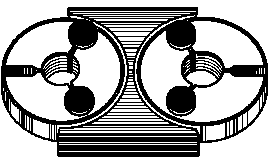

Figure 6–6. Go/No-Go thread ring gages in a holder (top)
and Go/No-Go thread plug gages (bottom).
